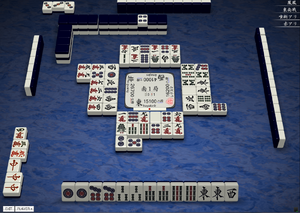Jigoku: Difference between revisions
mNo edit summary |
mNo edit summary |
||
| Line 4: | Line 4: | ||
|fu = Variable | |fu = Variable | ||
|type = Any | |type = Any | ||
|available = 1 | |available = 1 | ||
|tilePattern = Any [[machi|pattern]] | |tilePattern = Any [[machi|pattern]] | ||
|gameExample = * [http://tenhou.net/0/?log=2014081309gm-0009-7447-f89229d5&tw=1 Hell wait] | |gameExample = * [http://tenhou.net/0/?log=2014081309gm-0009-7447-f89229d5&tw=1 Hell wait] | ||
Revision as of 20:44, 30 March 2015
| Kanji | 地獄 |
|---|---|
| English | Hell wait |
| Fu | Variable |
| Tile types waiting | Any sided wait |
| Tiles available | 1 tile |
| Pattern example | Any pattern |
| Tenhou.net example |
Jigoku 「地獄」 is a special type of tenpai wait pattern, by which only one waiting tile is available to win. At least, this is the case in the vision of the player. For all a player knows, that last needed tile may either be in possession of another player or resides in the dead wall.
Wait strength
Aside from karaten, this is the weakest choice for a wait, because of the number of available tiles to win: one. However, the solitary tile may actually be strong, as players may view it as a safe tile; and therefore, one player may discard it. The wait would be better still with the addition of suji and/or kabe, or even with an honor tile with two already discarded. In essence, choosing this wait may come in the form of a trap, luring unsuspecting players. This wait is best used for emergency situations, such as being in last place at oorasu and other dire circumstances.
External links

| ||||||||||||||||||||||
